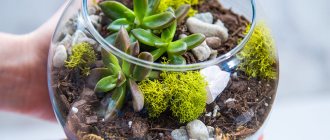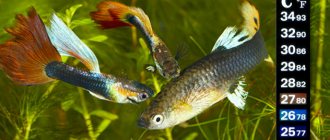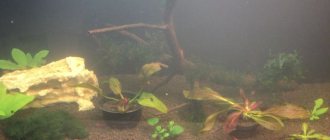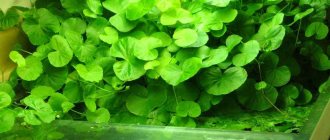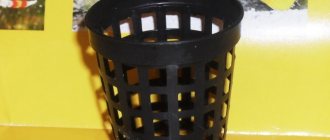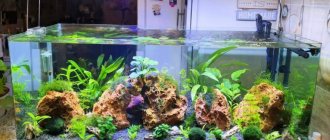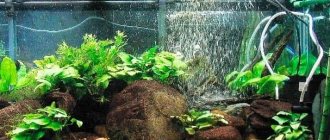Lush green thickets of plants with fragrant, rich flowers evoke thoughts of warm summer and vacation, so many people are attracted by the idea of creating their own winter garden in the house. However, impressive greenhouses will take up a lot of space, and caring for so many plants will hit the owner's pocket hard. In small houses, a florarium, or, as it is called, a miniature garden in an aquarium, will replace the greenhouse. Thanks to a specially created microclimate, flowers in the aquarium are able to grow, bloom and develop, attracting the gaze of enthusiastic owners.
Features of flowers in the aquarium
To create a mini garden in an aquarium, called a florarium, glass tanks of a certain shape are used. They are filled with various types of vegetation and decorative elements.
There are many options for mini aquarium gardens. Among the extensive list are:
- Sealed or open structures.
- Nano models and large containers.
- A garden in an aquarium with lighting and heating equipment.
- Containers with and without liquid.
- Wall-mounted, hanging and floor-mounted models.
- Models that are installed on a window sill or on a stand.
To create succulents with flowers with your own hands, aquarists use:
- Bottles.
- Aquariums.
- Glass aquariums.
- Banks.
List of suitable containers and materials for decoration
The vase is multifaceted.
The following are suitable containers for a garden behind glass:
- round glass aquariums;
- frameless rectangular home ponds made of glass or plastic;
- multifaceted geometric vases (assembled independently using patterns);
- bottles and glass jars of unusual shape, with and without corks;
- glasses, glasses, teapots with a transparent body, vases without decoration;
- opaque ceramic and glass flat vases, candy bowls, etc. (for open and water compositions);
- laboratory glassware;
- Christmas balls and incandescent lamps.
For the first experiment, a sealed plastic container with transparent walls or a glass vase is suitable.
In addition to plants, the composition can include:
- tree branches or driftwood on which it is convenient to attach moss;
- stones and shells, lava flows (sold in aquarium departments);
- models of buildings, figurines of animals or insects, pearls and pieces of coral (for a seascape);
- pine cones, dried flowers and other natural material.
What will you need?
In order to create a composition in an aquarium, which is called a florarium, with your own hands, you will need certain elements and tools.
- Glass tank. A round aquarium is suitable for these purposes. Aquarists often plant vegetation in a spherical tank. Other containers made of glass are also suitable for these purposes.
- Substrate. To create succulents with your own hands, use pebbles, large expanded clay or sandstone. It is necessary to prepare a lot of substrate, since excess water is stored in it. Only with the required amount of drainage is the likelihood of root system oxidation reduced.
- Activated carbon. This component is introduced into the substrate in order to get rid of extraneous odors. As a rule, activated carbon is introduced into the container if tropical aquariums with vegetation are created.
- Soil for vegetation. For normal development, succulents need fine sand. If orchids are grown in a tank, then soil with tree bark is prepared.
- Selection of flowers and vegetation. It is better to give preference to indoor plants in the aquarium that grow slowly.
- Decor. To create unique compositions, a variety of figurines made of plaster, ceramics or glass, moss, and other decor are suitable.
- Tools. To prepare and decorate containers, you need a certain tool.
Where to put the florarium
The choice of location for a garden behind glass depends on the type of plants. This is especially carefully taken into account when cultivating flowers in a closed container: the temperature inside can rise to critical levels if the container is left in the sun. The best place is next to a window that receives the sun only a few hours a day.
A small decorative vessel can be conveniently placed on a desktop or bookshelf. If you have containers of different sizes, then when you decorate them in the same style, you can create a large composition by placing all the containers on a rack.
Vegetation selection
Not all flowers are planted in an aquarium. Some species develop quickly and therefore die in a confined space. Planted in the container:
- Miniature fern. It is distinguished by wavy leaves.
- Moss. Using moss, the substrate is decorated, the bottom and decorative components are filled.
- Plaunkaceae and Crotonaceae. With their help, the tank is filled with bright colors and greenery.
- Orchids, violets. These aquarium flowers are easy to care for.
- Cacti, both decorative and flowering.
Succulents are often used to fill florariums. They are popular because:
- Unpretentiousness.
- Easy to care for.
- Brightness.
- Attractiveness.
- Watering them does not require much water.
Succulents are used together with other representatives of the flora, fish and shellfish phenotypes. With their help, they create unique compositions.
Which plants are suitable for growing behind glass?
Its spectacular appearance depends on the correct choice of inhabitants of a plant terrarium. In a composition of several specimens, you can include contrasting plants (with different heights or colors). Sometimes a florarium is decorated with only one accent bush, and the rest serves only as a background (for example, a mini violet on a moss cushion). In the rocky interior, the mountain landscape will be recreated by succulents, and miniature water lilies (tiger lotus, etc.) will complement the open mini-pond in the room.
The main criterion for selecting plants is a size of no more than 20 cm and a low growth rate. Representatives of large-leaved species in a small container will look crushed and crushed, and fast-growing flora will have to be replanted frequently.
Cacti are suitable for growing behind glass.
Best filling options:
- cacti and succulents;
- mosses and selaginella;
- small representatives of ferns (pteris, asplenium, etc.);
- mini violets;
- lithops;
- fittonia, etc.
Plants are selected so that 50% of the volume of the vessel remains unfilled.
Succulents in an aquarium
Succulent plants (agave, zamioculcas, aloe, sansevieria, haworthia, etc.) are the best option for filling a mini-garden. From them you can create compositions with a hint of semi-desert and mountain landscapes, fantasy landscapes, a piece of tropical forest, etc.
A feature of succulent plants is their undemanding nature when it comes to watering. By accumulating moisture in succulent stems and leaves, they do not suffer from the forgetfulness of their owners and do not lose their spectacular appearance. In unfavorable conditions, plants enter periods of dormancy, stopping their growing season. This property can be used to regulate the growth of a number of succulents (for example, Kalanchoe).
Planting vegetation without water
Before making a florarium for flowers with your own hands, prepare containers and pots.
Before doing everything, a pre-selected substrate is poured into the bottom of the container. If necessary, stones and other decorative elements are scattered along the bottom.
After this, perform the following actions:
- Holes are prepared in the soil, the diameter of which is from 3 to 5 mm.
- The holes are filled with water.
- The packaging is removed from the root system. The plant is placed in the hole.
- The soil around the root system is thoroughly compacted. This procedure is performed using an eraser.
Creation
How to make a florarium yourself:
- First, a thin layer of sand or stones is placed in the vessel, then a layer of soil is poured for planting.
- The flower is prepared for planting.
- Form depressions with a diameter of 3-5 mm in the soil, pour a little water into them.
- The roots of the flower are lowered into the hole and watered a little so that the roots straighten. When planting tiny flowers, use tweezers.
- The soil is compacted using a light small object. At the end of planting, the surface is lightly dusted with soil or sand.
When planting vegetation, you should make sure that the leaves of the flowers do not touch the walls, otherwise the leaves will dry out. At first, the vegetation is watered frequently, and when the microclimate is depleted, the number and volume of watering decreases.
The purpose of the florarium is to decorate the room space and observe the development of your favorite flowers. A miniature garden in an aquarium will not take up much space, and with proper care it will delight the owner for a long time.
Lighting
Both standard florariums and aquariums with plants and fish require lighting. LED strip or fluorescent lamps are suitable for these purposes. You can make such lighting equipment yourself.
- Energy efficiency. This type of lighting is characterized by maximum efficiency.
- Safety. Since the voltage is 12 Volts, such lighting will not cause any harm to representatives of flora and fauna.
- Availability of adjustment. Through such an element the degree of luminous flux changes.
- Possibility to choose the shade of light. Different plants require a certain spectrum. In accordance with this, LEDs are selected.
Trends in florarium design
As in any form of creativity, the creation of florariums has its own trends, tendencies, and current techniques. They talk about the principles of aesthetics that should be followed in order to remain “in fashion.”
Of course, it is not necessary to strictly follow them, but it is necessary to get acquainted with them in order to be able to find the direction and style in which you want to work. So let's get acquainted:
Coniferous compositions
They will create a great “winter” atmosphere. The needles will look best in polyhedral flasks, and it is ideal if the sides of the flask are trimmed with wood.
Cubic large format florarium
A florarium filled with mosses, driftwood and algae-like plants is also on trend. By the way, you can plant, for example, a small land snail in such a floririum - you get a whole terrarium.
Flasks in the form of vases or bottles
Orchids or other exotic original flowers are placed inside the flasks; the flasks look incredibly attractive.
Flask glass
A stabilized rose is placed inside, it looks fresh, original and even fabulous.
Various-sized florarium spheres
With succulents, suspended in the air at different levels, they create an inexpressible airiness, lightness, and enchanting atmosphere.
Creating florariums and caring for them is an amazing, attractive art that is not so difficult to master, but you will want to enjoy the result again and again! And this is a fascinating creative process, which our online hypermarket will help facilitate. Flasks of non-standard shapes and sizes, grounds, decor - the most difficult thing will be required of you: let your imagination fly to create a small masterpiece - an oasis in glass!
Rules of care
- Watering. Water should be introduced into florariums carefully. After all, an excess of water will cause damage to the root system. The degree of humidity is controlled manually or using tools.
- Trimming. In order for vegetation and flowers to develop well, side shoots are periodically removed. They interfere with normal development.
- Introduction of fertilizers. The introduction of mineral fertilizers is carried out carefully. Their excess leads to the accumulation of salts that do not dissolve. Salts affect the shade of shady plants and flowers.
- Lighting. The duration of daylight hours is set individually. Different species require one type of lighting or another.
Creating a mini-garden in an aquarium is a fascinating activity that both beginners and experienced aquarists can handle. All necessary items can be easily purchased in specialized stores. When selecting vegetation, the features of maintenance and care, pruning and feeding are taken into account.
Why are florariums so popular?
The first analogues of florariums appeared a long time ago - already in the 19th century. Then a real fashion arose for exotic plants that did not want to take root even in the greenhouse conditions of greenhouses. That is why a special box was invented, inside which an ideal climate was created for capricious flowers. And this idea turned out to be brilliant, because the plants not only did not die, but also grew and bloomed, allowing us to see with our own eyes the incredible attractiveness of rare flowers.
However, the real “boom” for florariums began quite recently - literally 2-3 years ago. And this is not surprising, because:
- they create beauty and “contemplation” of the aquarium, but do not require such careful and thorough care. Some florariums are generally completely or almost completely autonomous and do not require human care;
- take up little space: unlike flower pots, florariums are very compact; the smallest of them are created in vessels no larger in size than a regular incandescent lamp. For lovers of “large formats” there is always the opportunity to choose larger oases;
- florariums relax and pacify. You can look at them for hours, enjoying the resulting composition, and this has a beneficial effect on psycho-emotional well-being;
- The process of creating them is creative and exciting. It allows you to realize the need for self-expression;
- ready-made florariums are an opportunity to please family and friends with stylish, charming gifts, and with a professional approach, they are also a source of additional income;
- You can keep florariums of a certain type even for people who suffer, for example, from allergies to certain types of plants. Closed, isolated structures will allow you to enjoy the beauty of flowers, but will not require sacrifices in terms of health and well-being;
- the compositions are so diverse that even people who are indifferent to plants will be able to choose an option that delights them.
A florarium is a “lazy aquarium”, no less beautiful, but much easier to care for. This is an ideal solution, for example, for a rented apartment, where it is impossible to radically change the decor or bring a pet, and a flask with a small oasis inside will solve both problems at once.
Best Live Plants for Beginners
To ensure that living plants do not die in the aquarium environment, they must be properly cared for. For those who have decided to start breeding fish with vegetation in a tank for the first time, we recommend choosing plant species that do not require special care for planting.
The best plants for beginner aquarists:
- Related Cryptocoryne - has beautiful leaf color. Grows in any water conditions.
- Cabomba is an undemanding and unpretentious plant, which is a lush green bush with fleshy stems.
- Nomaphyla straight - grows as a dense bush. It is distinguished by its aesthetic appeal and is undemanding in care.
- Cirrus is a beautiful plant that quickly forms dense openwork thickets.
- Key moss is an absolutely undemanding plant in terms of temperature and lighting.
- Thailand fern - grows well even in poor light. Forms spectacular dense thickets.
- Wing fern is an unpretentious species and grows well in a floating state, but there is one important need - bright lighting.
Even simple and unpretentious plant species can beautifully decorate an aquarium and create favorable microflora for the life of fish.
Ferns and mosses
Ferns and mosses are quite popular types of aquarium plants that do not form inflorescences and a full-fledged root system. However, they look attractive in an aquatic environment and require virtually no maintenance.
Types of aquarium ferns and mosses:
- bolbitis;
- Azolla;
- star moss;
- pearl moss;
- prickly moss;
- callicostella;
- lomariopsis;
- Malayan fern;
- moss Cameroon;
- carpet moss;
- Ricardia moss;
- nano-moss;
- orange fern;
- Trident fern;
- angustifolia fern;
- Riccia floating;
- salvinia;
- phylonotis;
- Fern Thor's Hammer.
Rosettes
Plants of the rosette group have one common feature - there is no pronounced stem, and the leaves grow from a single center called the rosette.
Popular rosette plants for the aquarium:
- Anubias;
- aponogeton;
- baldellia;
- blixa;
- small swamp;
- Willisneria;
- watercolor;
- water orchid;
- water cabbage;
- crinum wavy;
- cryptocoryne;
- water lily;
- leleopsis;
- water ranunculus;
- nymphea;
- duckweed;
- teloresis;
- chelantium;
- Eleocharis.
Stem
Stem plants decorate the aquarium and create a favorable environment for the inhabitants of the artificial pond. Not all plants from this category are characterized by unpretentiousness. Some types of stem flora are quite capricious to care for.
Types of stem plants for aquariums:
- Avran officinalis;
- Aldrovanda vesica;
- alternanthera;
- Ammania gracilis;
- aciotis;
- bacopa;
- blixa;
- Bucephalandra;
- water yarrow;
- hygrophila;
- gratiola;
- Amano pearl grass;
- limnophila;
- ludwigia;
- Murdannia;
- naiad;
- ophiopogon;
- pinnate;
- persicaria;
- pogostemon;
- hornwort;
- rotala;
- staurogyne;
- fineness;
- cyanotis;
- elodea;
- Egeria.
Application in the interior
The purpose of florariums is contemplation and decoration of the interior , the opportunity to refresh it without taking up a lot of space. This is a precious decoration for any room. Whatever the “garden in an aquarium” is, it will be the real pride of any owner.
Without a doubt, this solution will decorate any home.
Have you decided to create a florarium? Dare, fantasize! This is a pleasant, interesting activity that does not take much time. The pleasure from the result will exceed any expectations.
Hygrophila polysperma
Green hygro is known as an extremely easy to grow and hardy freshwater aquarium plant, although due to its high growth rate it requires a fair amount of pruning.
Trimming green hygro will also cause it to grow even more, so you can use it as a way to encourage leaf regrowth in areas that are starting to brown.
The plant is rooted in the substrate at the bottom of your aquarium, but you can use almost any type of substrate as it gets its nutrients from the water column.
While green hygro is compatible with almost any freshwater tank and is not usually bothered by herbivorous fish, it may be bothered by goldfish or burrowing cichlids.
Do-it-yourself soil for an aquarium
Fish need soil in an aquarium just as we need soil under our feet. It is in it that plants grow, various inhabitants of the underwater world swarm and spawn. Thanks to correctly selected and placed soil, biological balance is maintained in the aquarium. It works as a kind of filter.
What kind of soil is needed for an aquarium?
It is often difficult for beginners to decide whether to choose natural or artificial soil for an aquarium. As a rule, natural soil is moderately decorative, but creates optimal conditions for the normal functioning of all microorganisms. These are sea pebbles, coarse-grained quartz sand, crushed rocks and minerals (granite, jasper, quartzite, serpentine).
DIY aquarium soil
- Add some inert quartz sand to the aquarium.
Let's add some "prepared soil". The soil for the aquarium is prepared as follows: it is kept in a flower pot for two months and watered with water from the aquarium. Such soil is saturated with nutrients (the necessary bacteria and microorganisms), which will help establish the desired balance.
Diseases of aquarium plants
Like any living organism, aquatic plants are susceptible to various diseases. They can be caused by various reasons, mainly by environmental factors. If the plant has any damage, then you first need to determine whether the damage is related to the activity of fish or snails. Next, you need to check whether the plants have enough available lighting. Its deficiency is expressed in thin stems, pale color of leaves and their discarding. And too much light makes the leaves small. Dense soil leads to blackening and death of roots.
The majority of diseases are associated with a lack of nutrients. Therefore, it is important to determine exactly which elements plants lack and make up for this deficiency.
Some diseases and their causes:
- If there is a lack of carbon, the plant may stop growing;
- Leaves with light and brown spots indicate a manganese deficiency;
- Blackness and mucus at the growing points - low calcium;
- Pale leaf color occurs due to iron deficiency;
- If the leaves become netted, then the plant does not have enough potassium;
- Leaves wither from lack of nitrogen and phosphorus;
- A lack of magnesium is expressed in the yellowness of the leaves and their further death in these places.
Execution options
A florarium is a composition of living plants behind glass. This is a Green paradise made up of decorative natural elements.
There are many options for creating . They can be:
- fully open and partially closed;
- large and miniature;
- with additional heating and lighting;
- with and without water;
- hanging, floor, wall;
- on a table or windowsill;
The vessels for such compositions are glass or simply light-transmitting containers: aquariums, jars, huge glasses and bottles.
In such unique conditions, it is easy to create a favorable microclimate, which is necessary for capricious tropical pets.
Blixa japonica
Blixa is very popular among aquarists - lovers of nano aquariums, and this is not surprising. The plant is not difficult to maintain, the long narrow leaves look very beautiful, and since the plant is popular, it is not difficult to buy it at a low price.
Blixa is a rosette plant with low growth and interesting leaf color. With good lighting and sufficient nutrients it grows very quickly, filling the available space in the aquarium.
Used to decorate the middle ground and background.
Useful tips
Choose a vessel made of natural glass. Plexiglas is not suitable. It becomes cloudy and scratched over time. The purpose of creating or purchasing a florarium is aesthetic pleasure and beauty.
Cleanliness is one of the most important factors in the creation and development of a flower arrangement. It is necessary to prepare and sterilize the elements of the florarium.
Plants can complement each other, but not be antagonists. Study the neighborhood issue carefully. Each species has individual requirements for microclimate, humidity, area and lighting.
The soil must correspond to the selected categories . A light sand mixture is suitable for succulents, soil based on tree bark is suitable for orchids, and ordinary flower soil is suitable for other plants.
The decor is part of the “highlight” of the florarium. The composition should look complete and harmonious, and fit into the interior.
Elodea
Another frequent guest in beginners' aquariums is Elodea. Its lush green shoots grow quickly (especially with sufficient light and CO2 supply) and are great for starting an aquarium for the first time.
Long, highly branched stems with pointed green leaves attract the eye and serve as reliable shelter for shy and cautious fish. In addition, elodea is an effective natural filter that purifies water from significant contaminants.
The homeland of most varieties of elodea is North America, so it is not accustomed to very warm water; when overheated, growth slows down and health deteriorates. The optimal temperature for its growth is 16-24°C with rare drops to 12°C. But the plant tolerates both soft and hard water quite easily and can exist without being anchored in the ground.
Rapid growth means that Elodea tends to crowd out other plant species from the aquarium, so its numbers must be controlled and, if necessary, excesses removed. During the pruning process, it is recommended to plant the plant in a separate container, because its juice contains substances that can be dangerous to the rest of the inhabitants of the aquarium.
